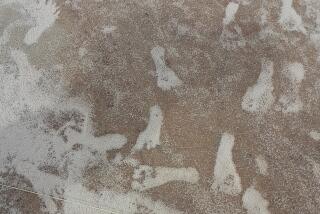Rebel Paleolithic artist breaks the rules, draws a campsite 13,800 years ago
Scientists have uncovered a rock engraving that may be the earliest known depiction of a human society.
The ancient engraving of what appears to be a hunter-gatherer camp dates back about 13,800 years to the Upper Paleolithic era. Seven objects that look like semi-circular huts were drawn on a slab of stone, probably with another rock or a pointed flint artifact.
The tableau was unearthed at the Moli del Salt site in Spain, about 30 miles west of Barcelona.
Archaeologists say the find is especially exciting because it breaks the rules of prehistoric art, which generally follow very strict stylistic and thematic conventions. For instance, these works usually involve animals, nonfigurative signs and the occasional human figure.
“We think that someone was experimenting with new themes, focusing for the first time on the social realm,” said Marcos Garcia-Diez and Manuel Vaquero, who described the engraving in a paper published last week in the journal PLOS One.
The huts in the engraving are arranged in three levels across a slab that measures 7 inches wide and 3 inches high. The largest of the seven huts is about 1.5 inches wide and 0.8 inch high.
Garcia-Diez, of the University of the Basque Country, and Vaquero, of the Catalan Institute of Human Paleoecology and Social Evolution, note that the artist appears to be trying to create a visual sense of depth.
When the engraved rock was initially discovered in 2013, it was unclear that it was anything special.
“It was very dirty and partially covered by a crust,” the Spanish researchers explained in a joint email. “Only some days later, when the cleaning of the slab was finished, were we aware of the importance of the piece.”
Although 12 other engraved objects were discovered at the site, this is the only one that departs from the artistic conventions of the time, the archaeologists said. All of the other pieces have depictions of animals or of signs linked to magic or religion — things that are typical of the late-Paleolithic style.
John Shea, archaeologist at Stony Brook University in New York, said that “Paleolithic people made sketches of all kinds of things,” but he agreed that their wall art tended to focus on animals and abstract signs.
“Indeed,” he said, there are “not a lot of pictures of people, plants, tools or architecture.”
Still, Shea added that artists from 13,800 years ago were probably less regimented than artists working today.
“All cultures have their implicit ‘rules’ about who or what gets shown in art,” Shea said. “Go through any art museum or art gallery and count up the ratio of depictions of naked women versus naked men, or the ratio of paintings of floral arrangements to pictures of outhouses.”
Of course, Garcia-Diez and Vaquero acknowledge that they can’t be certain the images depicted on the slab are indeed a campsite, or a deliberate attempt by the engraver to break with tradition.
“We are afraid the only way to be 100% sure would be to have the artist in front of us and ask him or her about his or her intentions,” they said. “However, we can think of no better explanation.”
To back up their interpretation, the study authors turned to ethnographic data from more recent hunter-gatherer societies. They wrote that domed huts with a beehive shape similar to those depicted in the engraving are the preferred style of temporary dwellings constructed by such societies throughout the world.
They also pointed to previous work that suggests groups described as “generic hunter-gatherers” make camp with an average of 3.9 to 7.6 individual households.
“The seven huts in the engraving fit perfectly with this mean number of households,” they wrote in the paper.
Depictions of homes become more common after the appearance of sedentary communities in Neolithic times several thousand years later, the Spanish researchers said.
So if those scratches on the rock were indeed meant to depict a human landscape, then the ancient rebel artist who made them was way ahead of his or her time.
Science rules! Follow me @DeborahNetburn and “like” Los Angeles Times Science & Health on Facebook.
MORE FROM SCIENCE
Masters of disguise: Cuttlefish can hide their electric fields
Couch potato in your 20s? Your brain may suffer in your 50s, study finds
If you’re having trouble quitting smoking, maybe you can blame your DNA







